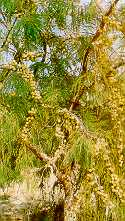View crop
View crop Data sheet EcoPortEmblica officinalis
 |
|
| Notes |
|---|
| BRIEF DESCRIPTION A small to medium-sized, handsome deciduous tree reaching up to 5-25 m in height, often with a crooked trunk up to 35 cm in diameter. USES The tree produce sour fruit that is eaten boiled, used in cooked food or as sweetmeat, pickle, jam, jelly or syrup and that also has medicinal properties. Immature fruits, leaves, roots and bark are rich in tannin. The leaves are also used as fodder and green manure. The timber is used for implements and sometimes for building, it is durable under water and can be used to build wells. It is also good for firewood and charcoal. GROWING PERIOD Perennial. The tree is rather slow-growing and usually only bear fruit when 6-8 years old. COMMON NAMES Emblic myrobalan, Indian gooseberry, Emblic, Myrobalan, Emblica, Myrobalan emblic, Aonla, Kimalaka, Malaka, Kemloko, Laka, Melaka, Ta-sha-pen, Khaam poomz, Ma-khaam pom, Kan-tot, Kam thuat, Chum ruot Me ru'ng. FURTHER INF Scientific synonym: Emblica officinalis. Indian gooseberry is common in grassy areas, bush, village groves and light forests at elevations between sea level and 1800 m. It only produces flowers at a daylength between 12-13.5 hours. It is fire resistant and is one of the first trees to recover after a fire. Annual fruit yields may be about 15-25 kg per tree. |
Sources |
| Lemmens R 1991 pp 105-108 [USE, LIG, PHO, PH, KTMP] Roecklein J 1987 pp 214 [USE] Duke J 1975 pp 24 [PH, RAIN, TEMP] |